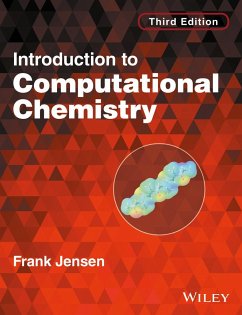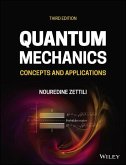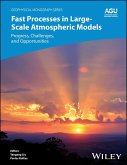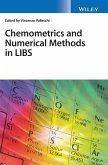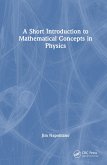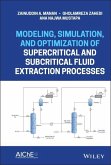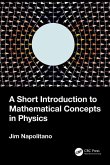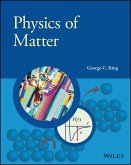Frank Jensen (Denmark Odense University)
Introduction to Computational Chemistry
Frank Jensen (Denmark Odense University)
Introduction to Computational Chemistry
- Broschiertes Buch
- Merkliste
- Auf die Merkliste
- Bewerten Bewerten
- Teilen
- Produkt teilen
- Produkterinnerung
- Produkterinnerung
Introduction to Computational Chemistry 3rd Edition provides a comprehensive account of the fundamental principles underlying different computational methods.
Andere Kunden interessierten sich auch für
![Quantum Mechanics Quantum Mechanics]() Nouredine Zettili (USA Jacksonville State University)Quantum Mechanics44,99 €
Nouredine Zettili (USA Jacksonville State University)Quantum Mechanics44,99 €![Fast Processes in Large-Scale Atmospheric Models Fast Processes in Large-Scale Atmospheric Models]() Fast Processes in Large-Scale Atmospheric Models242,99 €
Fast Processes in Large-Scale Atmospheric Models242,99 €![Chemometrics and Numerical Methods in Libs Chemometrics and Numerical Methods in Libs]() Chemometrics and Numerical Methods in Libs156,99 €
Chemometrics and Numerical Methods in Libs156,99 €![A Short Introduction to Mathematical Concepts in Physics A Short Introduction to Mathematical Concepts in Physics]() Jim NapolitanoA Short Introduction to Mathematical Concepts in Physics152,99 €
Jim NapolitanoA Short Introduction to Mathematical Concepts in Physics152,99 €![Modeling, Simulation, and Optimization of Supercritical and Subcritical Fluid Extraction Processes Modeling, Simulation, and Optimization of Supercritical and Subcritical Fluid Extraction Processes]() Zainuddin A. Manan (Universiti Teknologi Malaysia. Malaysia)Modeling, Simulation, and Optimization of Supercritical and Subcritical Fluid Extraction Processes121,99 €
Zainuddin A. Manan (Universiti Teknologi Malaysia. Malaysia)Modeling, Simulation, and Optimization of Supercritical and Subcritical Fluid Extraction Processes121,99 €![A Short Introduction to Mathematical Concepts in Physics A Short Introduction to Mathematical Concepts in Physics]() Jim NapolitanoA Short Introduction to Mathematical Concepts in Physics57,99 €
Jim NapolitanoA Short Introduction to Mathematical Concepts in Physics57,99 €![Physics of Matter Physics of Matter]() George C. King (UK University of Manchester)Physics of Matter70,99 €
George C. King (UK University of Manchester)Physics of Matter70,99 €-
-
-
Introduction to Computational Chemistry 3rd Edition provides a comprehensive account of the fundamental principles underlying different computational methods.
Hinweis: Dieser Artikel kann nur an eine deutsche Lieferadresse ausgeliefert werden.
Hinweis: Dieser Artikel kann nur an eine deutsche Lieferadresse ausgeliefert werden.
Produktdetails
- Produktdetails
- Verlag: Wiley / Wiley & Sons
- Artikelnr. des Verlages: 1W118825990
- 3. Aufl.
- Seitenzahl: 672
- Erscheinungstermin: 3. Februar 2017
- Englisch
- Abmessung: 246mm x 174mm x 35mm
- Gewicht: 962g
- ISBN-13: 9781118825990
- ISBN-10: 1118825993
- Artikelnr.: 47485361
- Herstellerkennzeichnung
- Libri GmbH
- Europaallee 1
- 36244 Bad Hersfeld
- gpsr@libri.de
- Verlag: Wiley / Wiley & Sons
- Artikelnr. des Verlages: 1W118825990
- 3. Aufl.
- Seitenzahl: 672
- Erscheinungstermin: 3. Februar 2017
- Englisch
- Abmessung: 246mm x 174mm x 35mm
- Gewicht: 962g
- ISBN-13: 9781118825990
- ISBN-10: 1118825993
- Artikelnr.: 47485361
- Herstellerkennzeichnung
- Libri GmbH
- Europaallee 1
- 36244 Bad Hersfeld
- gpsr@libri.de
Professor Frank Jensen, Department of Chemistry, Aarhus University, Denmark Frank Jensen obtained his Ph.D. from UCLA in 1987 with Professors C. S. Foote and K. N. Houk, and is currently an Associate Professor in the Department of Chemistry, Aarhus University, Denmark. He has published over 120 papers and articles, and has been a member of the editorial boards of Advances in Quantum Chemistry (2005 - 2011) and the International Journal of Quantum Chemistry (2006-2011).
Preface to the First Edition xv
Preface to the Second Edition xix
Preface to the Third Edition xxi
1 Introduction 1
1.1 Fundamental Issues 2
1.2 Describing the System 3
1.3 Fundamental Forces 3
1.4 The Dynamical Equation 5
1.5 Solving the Dynamical Equation 7
1.6 Separation of Variables 8
1.7 Classical Mechanics 11
1.8 Quantum Mechanics 13
1.9 Chemistry 18
References 19
2 Force Field Methods 20
2.1 Introduction 20
2.2 The Force Field Energy 21
2.3 Force Field Parameterization 53
2.4 Differences in Atomistic Force Fields 62
2.5 Water Models 66
2.6 Coarse Grained Force Fields 67
2.7 Computational Considerations 69
2.8 Validation of Force Fields 71
2.9 Practical Considerations 73
2.10 Advantages and Limitations of Force Field Methods 73
2.11 Transition Structure Modeling 74
2.12 Hybrid Force Field Electronic Structure Methods 78
References 82
3 Hartree-Fock Theory 88
3.1 The Adiabatic and Born-Oppenheimer Approximations 90
3.2 Hartree-FockTheory 94
3.3 The Energy of a Slater Determinant 95
3.4 Koopmans' Theorem 100
3.5 The Basis Set Approximation 101
3.6 An Alternative Formulation of the Variational Problem 105
3.7 Restricted and Unrestricted Hartree-Fock 106
3.8 SCF Techniques 108
3.9 Periodic Systems 119
References 121
4 Electron Correlation Methods 124
4.1 Excited Slater Determinants 125
4.2 Configuration Interaction 128
4.3 Illustrating how CI Accounts for Electron Correlation, and the RHF Dissociation Problem 135
4.4 The UHF Dissociation and the Spin Contamination Problem 138
4.5 Size Consistency and Size Extensivity 142
4.6 Multiconfiguration Self-Consistent Field 143
4.7 Multireference Configuration Interaction 148
4.8 Many-Body Perturbation Theory 148
4.9 Coupled Cluster 157
4.10 Connections between Coupled Cluster, Configuration Interaction and Perturbation Theory 162
4.11 Methods Involving the Interelectronic Distance 166
4.12 Techniques for Improving the Computational Efficiency 169
4.13 Summary of Electron Correlation Methods 174
4.14 Excited States 176
4.15 Quantum Monte Carlo Methods 183
References 185
5 Basis Sets 188
5.1 Slater- and Gaussian-Type Orbitals 189
5.2 Classification of Basis Sets 190
5.3 Construction of Basis Sets 194
5.4 Examples of Standard Basis Sets 200
5.5 Plane Wave Basis Functions 208
5.6 Grid and Wavelet Basis Sets 210
5.7 Fitting Basis Sets 211
5.8 Computational Issues 211
5.9 Basis Set Extrapolation 212
5.10 Composite Extrapolation Procedures 215
5.11 Isogyric and Isodesmic Reactions 222
5.12 Effective Core Potentials 223
5.13 Basis Set Superposition and Incompleteness Errors 226
References 228
6 Density Functional Methods 233
6.1 Orbital-Free Density Functional Theory 234
6.2 Kohn-Sham Theory 235
6.3 Reduced Density Matrix and Density Cumulant Methods 237
6.4 Exchange and Correlation Holes 241
6.5 Exchange-Correlation Functionals 244
6.6 Performance of Density Functional Methods 258
6.7 Computational Considerations 260
6.8 Differences between Density Functional Theory and Hartree-Fock
Preface to the Second Edition xix
Preface to the Third Edition xxi
1 Introduction 1
1.1 Fundamental Issues 2
1.2 Describing the System 3
1.3 Fundamental Forces 3
1.4 The Dynamical Equation 5
1.5 Solving the Dynamical Equation 7
1.6 Separation of Variables 8
1.7 Classical Mechanics 11
1.8 Quantum Mechanics 13
1.9 Chemistry 18
References 19
2 Force Field Methods 20
2.1 Introduction 20
2.2 The Force Field Energy 21
2.3 Force Field Parameterization 53
2.4 Differences in Atomistic Force Fields 62
2.5 Water Models 66
2.6 Coarse Grained Force Fields 67
2.7 Computational Considerations 69
2.8 Validation of Force Fields 71
2.9 Practical Considerations 73
2.10 Advantages and Limitations of Force Field Methods 73
2.11 Transition Structure Modeling 74
2.12 Hybrid Force Field Electronic Structure Methods 78
References 82
3 Hartree-Fock Theory 88
3.1 The Adiabatic and Born-Oppenheimer Approximations 90
3.2 Hartree-FockTheory 94
3.3 The Energy of a Slater Determinant 95
3.4 Koopmans' Theorem 100
3.5 The Basis Set Approximation 101
3.6 An Alternative Formulation of the Variational Problem 105
3.7 Restricted and Unrestricted Hartree-Fock 106
3.8 SCF Techniques 108
3.9 Periodic Systems 119
References 121
4 Electron Correlation Methods 124
4.1 Excited Slater Determinants 125
4.2 Configuration Interaction 128
4.3 Illustrating how CI Accounts for Electron Correlation, and the RHF Dissociation Problem 135
4.4 The UHF Dissociation and the Spin Contamination Problem 138
4.5 Size Consistency and Size Extensivity 142
4.6 Multiconfiguration Self-Consistent Field 143
4.7 Multireference Configuration Interaction 148
4.8 Many-Body Perturbation Theory 148
4.9 Coupled Cluster 157
4.10 Connections between Coupled Cluster, Configuration Interaction and Perturbation Theory 162
4.11 Methods Involving the Interelectronic Distance 166
4.12 Techniques for Improving the Computational Efficiency 169
4.13 Summary of Electron Correlation Methods 174
4.14 Excited States 176
4.15 Quantum Monte Carlo Methods 183
References 185
5 Basis Sets 188
5.1 Slater- and Gaussian-Type Orbitals 189
5.2 Classification of Basis Sets 190
5.3 Construction of Basis Sets 194
5.4 Examples of Standard Basis Sets 200
5.5 Plane Wave Basis Functions 208
5.6 Grid and Wavelet Basis Sets 210
5.7 Fitting Basis Sets 211
5.8 Computational Issues 211
5.9 Basis Set Extrapolation 212
5.10 Composite Extrapolation Procedures 215
5.11 Isogyric and Isodesmic Reactions 222
5.12 Effective Core Potentials 223
5.13 Basis Set Superposition and Incompleteness Errors 226
References 228
6 Density Functional Methods 233
6.1 Orbital-Free Density Functional Theory 234
6.2 Kohn-Sham Theory 235
6.3 Reduced Density Matrix and Density Cumulant Methods 237
6.4 Exchange and Correlation Holes 241
6.5 Exchange-Correlation Functionals 244
6.6 Performance of Density Functional Methods 258
6.7 Computational Considerations 260
6.8 Differences between Density Functional Theory and Hartree-Fock
Preface to the First Edition xv
Preface to the Second Edition xix
Preface to the Third Edition xxi
1 Introduction 1
1.1 Fundamental Issues 2
1.2 Describing the System 3
1.3 Fundamental Forces 3
1.4 The Dynamical Equation 5
1.5 Solving the Dynamical Equation 7
1.6 Separation of Variables 8
1.7 Classical Mechanics 11
1.8 Quantum Mechanics 13
1.9 Chemistry 18
References 19
2 Force Field Methods 20
2.1 Introduction 20
2.2 The Force Field Energy 21
2.3 Force Field Parameterization 53
2.4 Differences in Atomistic Force Fields 62
2.5 Water Models 66
2.6 Coarse Grained Force Fields 67
2.7 Computational Considerations 69
2.8 Validation of Force Fields 71
2.9 Practical Considerations 73
2.10 Advantages and Limitations of Force Field Methods 73
2.11 Transition Structure Modeling 74
2.12 Hybrid Force Field Electronic Structure Methods 78
References 82
3 Hartree-Fock Theory 88
3.1 The Adiabatic and Born-Oppenheimer Approximations 90
3.2 Hartree-FockTheory 94
3.3 The Energy of a Slater Determinant 95
3.4 Koopmans' Theorem 100
3.5 The Basis Set Approximation 101
3.6 An Alternative Formulation of the Variational Problem 105
3.7 Restricted and Unrestricted Hartree-Fock 106
3.8 SCF Techniques 108
3.9 Periodic Systems 119
References 121
4 Electron Correlation Methods 124
4.1 Excited Slater Determinants 125
4.2 Configuration Interaction 128
4.3 Illustrating how CI Accounts for Electron Correlation, and the RHF Dissociation Problem 135
4.4 The UHF Dissociation and the Spin Contamination Problem 138
4.5 Size Consistency and Size Extensivity 142
4.6 Multiconfiguration Self-Consistent Field 143
4.7 Multireference Configuration Interaction 148
4.8 Many-Body Perturbation Theory 148
4.9 Coupled Cluster 157
4.10 Connections between Coupled Cluster, Configuration Interaction and Perturbation Theory 162
4.11 Methods Involving the Interelectronic Distance 166
4.12 Techniques for Improving the Computational Efficiency 169
4.13 Summary of Electron Correlation Methods 174
4.14 Excited States 176
4.15 Quantum Monte Carlo Methods 183
References 185
5 Basis Sets 188
5.1 Slater- and Gaussian-Type Orbitals 189
5.2 Classification of Basis Sets 190
5.3 Construction of Basis Sets 194
5.4 Examples of Standard Basis Sets 200
5.5 Plane Wave Basis Functions 208
5.6 Grid and Wavelet Basis Sets 210
5.7 Fitting Basis Sets 211
5.8 Computational Issues 211
5.9 Basis Set Extrapolation 212
5.10 Composite Extrapolation Procedures 215
5.11 Isogyric and Isodesmic Reactions 222
5.12 Effective Core Potentials 223
5.13 Basis Set Superposition and Incompleteness Errors 226
References 228
6 Density Functional Methods 233
6.1 Orbital-Free Density Functional Theory 234
6.2 Kohn-Sham Theory 235
6.3 Reduced Density Matrix and Density Cumulant Methods 237
6.4 Exchange and Correlation Holes 241
6.5 Exchange-Correlation Functionals 244
6.6 Performance of Density Functional Methods 258
6.7 Computational Considerations 260
6.8 Differences between Density Functional Theory and Hartree-Fock
Preface to the Second Edition xix
Preface to the Third Edition xxi
1 Introduction 1
1.1 Fundamental Issues 2
1.2 Describing the System 3
1.3 Fundamental Forces 3
1.4 The Dynamical Equation 5
1.5 Solving the Dynamical Equation 7
1.6 Separation of Variables 8
1.7 Classical Mechanics 11
1.8 Quantum Mechanics 13
1.9 Chemistry 18
References 19
2 Force Field Methods 20
2.1 Introduction 20
2.2 The Force Field Energy 21
2.3 Force Field Parameterization 53
2.4 Differences in Atomistic Force Fields 62
2.5 Water Models 66
2.6 Coarse Grained Force Fields 67
2.7 Computational Considerations 69
2.8 Validation of Force Fields 71
2.9 Practical Considerations 73
2.10 Advantages and Limitations of Force Field Methods 73
2.11 Transition Structure Modeling 74
2.12 Hybrid Force Field Electronic Structure Methods 78
References 82
3 Hartree-Fock Theory 88
3.1 The Adiabatic and Born-Oppenheimer Approximations 90
3.2 Hartree-FockTheory 94
3.3 The Energy of a Slater Determinant 95
3.4 Koopmans' Theorem 100
3.5 The Basis Set Approximation 101
3.6 An Alternative Formulation of the Variational Problem 105
3.7 Restricted and Unrestricted Hartree-Fock 106
3.8 SCF Techniques 108
3.9 Periodic Systems 119
References 121
4 Electron Correlation Methods 124
4.1 Excited Slater Determinants 125
4.2 Configuration Interaction 128
4.3 Illustrating how CI Accounts for Electron Correlation, and the RHF Dissociation Problem 135
4.4 The UHF Dissociation and the Spin Contamination Problem 138
4.5 Size Consistency and Size Extensivity 142
4.6 Multiconfiguration Self-Consistent Field 143
4.7 Multireference Configuration Interaction 148
4.8 Many-Body Perturbation Theory 148
4.9 Coupled Cluster 157
4.10 Connections between Coupled Cluster, Configuration Interaction and Perturbation Theory 162
4.11 Methods Involving the Interelectronic Distance 166
4.12 Techniques for Improving the Computational Efficiency 169
4.13 Summary of Electron Correlation Methods 174
4.14 Excited States 176
4.15 Quantum Monte Carlo Methods 183
References 185
5 Basis Sets 188
5.1 Slater- and Gaussian-Type Orbitals 189
5.2 Classification of Basis Sets 190
5.3 Construction of Basis Sets 194
5.4 Examples of Standard Basis Sets 200
5.5 Plane Wave Basis Functions 208
5.6 Grid and Wavelet Basis Sets 210
5.7 Fitting Basis Sets 211
5.8 Computational Issues 211
5.9 Basis Set Extrapolation 212
5.10 Composite Extrapolation Procedures 215
5.11 Isogyric and Isodesmic Reactions 222
5.12 Effective Core Potentials 223
5.13 Basis Set Superposition and Incompleteness Errors 226
References 228
6 Density Functional Methods 233
6.1 Orbital-Free Density Functional Theory 234
6.2 Kohn-Sham Theory 235
6.3 Reduced Density Matrix and Density Cumulant Methods 237
6.4 Exchange and Correlation Holes 241
6.5 Exchange-Correlation Functionals 244
6.6 Performance of Density Functional Methods 258
6.7 Computational Considerations 260
6.8 Differences between Density Functional Theory and Hartree-Fock

